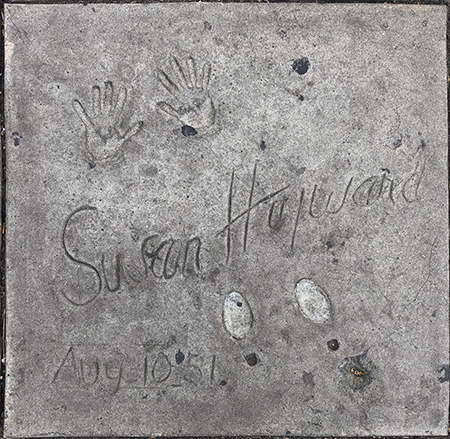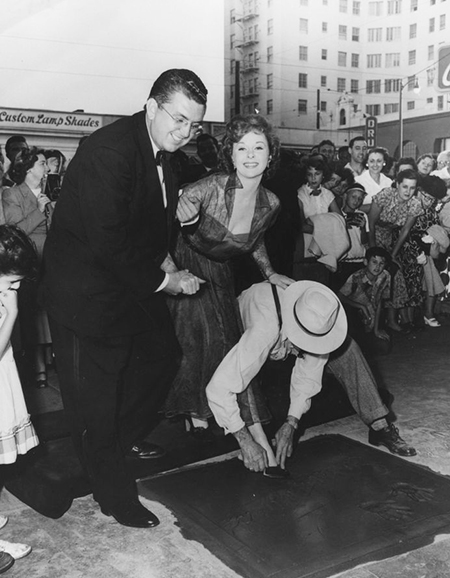 |
 |
|
|
| Susan Hayward |
 |
| Forecourt Ceremony held on Friday, August 10, 1951 |
| |
Born: Edythe Marrenner, June 30, 1917, in Brooklyn, New York
Age at the time of the ceremony: 34
Died: March 14, 1975, in Beverly Hills, California, age 57 |
| |
Susan Hayward was one of the most popular stars of the late 1940s and 50s. After a short stint as a model, she starred in a series of "sob-sister" films, which made her a household name.
Born to parents of Irish and Swedish descent, Edythe's grandmother was an actress, inspiring the young girl to tread the boards. In high school, she acted in the school productions, earning her the classic designation "Most Dramatic" by her classmates upon graduation in 1935.
Hoping to play Scarlett O'Hara in the film of Gone with the Wind, Edythe changed her name to Susan Hayward, did some modelling, and lit out for Hollywood. Hayward joined the long list of actressess who were considered for the role, but as we know, she didn't get it.
Undaunted, Hayward rattled about Hollywood, doing bits parts, until she was cast as the female lead in the Gary Cooper version of Beau Geste (released in July 1939). Impressed, Cecil B. DeMille put her as the third female lead in Reap the Wild Wind (released in March 1942), and co-starred with John Wayne again in The Fighting Seabees (released in January 1944). She starred with William Benix in an adaptation of Eugene O'Neil's The Hairy Ape (which played the Chinese in August 1944), so Hayward's acting chops were on display in a big way.
Signed to a lucrative seven-year contract by producer Walter Wanger, their first film together was Canyon Passage (released in July 1946) starring Dana Andrews. Their second film brought Hayward the first of her five Oscar nominations: Smash-Up, the Story of a Woman (released in March 1947), which placed Hayward in the central role of a signer in a downward spiral — sort of a variant of A Star is Born.
Hayward was now in her element playing flawed but strong women being dealt lousy cards by life. Wagner put her in the Civil War drama Tap Roots (releasded in August 1948) with Van Heflin; she was loaned out to Sam Goldwyn for My Foolish Heart (released in January 1950), and even though the story is all about her character, Hayward got second billing under Dana Andrews.
At Fox, Hayward starred with Gregory Peck in David and Bathsheba (which played the Chinese in August 1951), and starred as the singer Jane Froman in the biopic With a Song in My Heart (played the Chinese in April 1952). She re-teamed with Gregory Peck in The Snows of Kilimanjaro (played in October 1952).
After playing First Lady Rachel Donelson Robards to Charlton Heston's Andrew Jackson in The President's Lady (released in May 1953), Hayward got the full CinemaScope DeLuxe Color treatment, co-starring with Victor Mature in the sequel to The Robe, Demitrius and the Gladiators (which played the Chinese in June 1954), then played actress Lillian Roth in the biopic I'll Cry Tomorrow (released in December 1955).
Switching back and forth between big films and smaller dramas, Hayward has a love/hate releationship with John Wayne playing Genghis Khan in producer Howard Hughes' notorious film The Conqueror (released in March 1956), but following that experience, she scored her personal best playing convicted murderer Barbara Graham in I Want to Live! (released in November 1958), for which she won the Best Actress Oscar.
Returning to the widescreen history books, Hayward starred as a frontier widow struggling to keep a ranch going in Woman Obsessed (released in May 1959) with Stephan Boyd. She then co-starred with Dean Martin in Ada (released in August 1961). Producer Ross Hunter got Hayward to star in his remake of Back Street (released in October 1961).
Hayward got to play yet another bitch / monster in Valley of the Dolls (which played the Chinese in December 1967), starred in a Las Vegas based staging of the musical of Mame, and attempted to make a television pilot called Say Goodbye, Maggie Cole for ABC in 1972, but the show was not picked up — Hayward had been diagnosed with brian cancer. She appeared in frail condition on the 1974 Oscar telecast, assisted to the stage by Charlton Heston. In March 1975, he suffered a fatal seizure at her home in Beverly Hills at the age of 57. |
|
|
|
|
| |
 |
 |
| Grauman's Chinese Theatre, Hollywood, California. Susan Hayward Forecourt block. Executed by Jean Klossner, Friday, August 10, 1951. 42 x 41 inches. |
 |
 |
 |
| Grauman's Chinese Theatre, Hollywood, California. Susan Hayward Forecourt ceremony, Friday, August 10, 1951. Chinese Theatre manager Ralph Hathaway assists Susan Hayward while cement artist Jean Klossner makes the imprint of Hayward's shoe. |
|
 |
|